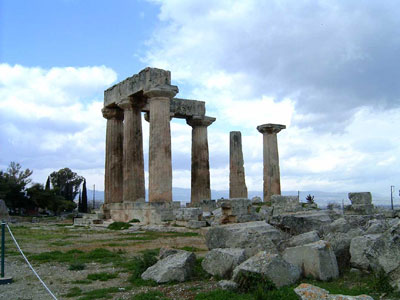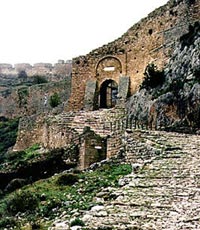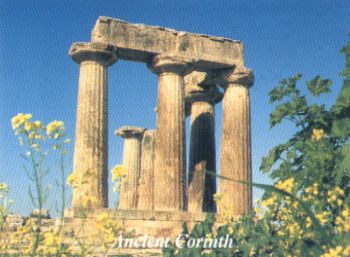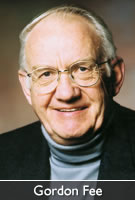Define Arsenokoites -
In ancient usage this word
DID NOT refer to homosexuals
Greek lexicons do not define arsenokoites
based on historical usage of that word.

The ruins of the Temple of Apollo at Corinth
rebuilt around 550 BC on the ruins of an
older temple. The temple of Apollo originally
had thirty-eight massive Doric columns
seven of which remain standing today.
The Greek Language Thesaurus, UC-Irvine, lists 73 occurrences of the arsenokoit stem from Paul’s first century AD usage beginning in 1 Corinthians 6:9 to AD 1453.
The Thesaurus Linguae Graecae (TLG®),
The Greek Language Thesaurus, is a research center at the University of California, Irvine. Founded in 1972 the TLG has collected and digitized most literary texts written in Greek, from Homer in the 8th century BC to the fall of Byzantium in AD 1453.
On this page we will briefly examine the first 56 uses of the arsenokoit stem in early church history.
TLG is only accessible by paid subscription but we have the information for you free, on this page, about how arsenokoitai was used by the ancient Greeks. Continue reading below.
Or, click this link to: explore the origin and meaning of arsenokoitai.
Define arsenokoites - The first 56 historical uses of the arsenokoit stem
- Paul, I Corinthians 6:9. This is the first historical use of the word. Paul does not define the meaning of arsenokoites.
- Paul, I Timothy 1:10. This is the second historical use of the word. Paul does not define the meaning of arsenokoites.
- Sibylline Oracle 2:70-78. The context is stealing, falsely accusing and murder. The meaning is not defined.
- Epistle of Ignatius to the Tarsians. Ignatius quotes I Corinthians 6:9 without providing a definition.
- Epistle of Polycarp to the Philippians. Polycarp quotes I Corinthians 6:9 without providing a definition.
- Define arsenokoites. Acts of John 36. The context is robber, defrauder, thief but no definition is provided. Arsenokoithj is translated sodomite here, which indicates a shrine prostitute. “36 Thou that rejoicest in gold and delightest thyself with ivory and jewels, when night falleth, canst thou behold what thou lovest? thou that art vanquished by soft raiment, and then leavest life, will those things profit thee in the place whither thou goest? And let the murderer know that the condign punishment is laid up for him twofold after his departure hence. Likewise also thou poisoner, sorcerer, robber, defrauder, sodomite [shrine prostitute], thief...” Acts of John, 36.
- Define arsenokoites. Clement of Alexandria, The Instructor 3.11. Clement twice quotes I Corinthians 6:9, without providing a definition.
- Define arsenokoites. Aristides, Apology, 13. Aristides, a Christian preacher, delivered his Apology around AD 125. The context was interspecies rape and Greek gods committing adultery, murder and arsenokoitia with humans.
 |
The Apostle Paul
walked Corinthian
streets like this in the
first century AD
Aristides was not describing homosexuality. He described interspecies sex, rape and adultery.
The preeminent story of a Greek god lying with a male is the myth of Zeus raping Ganymede. The Gnostic version of this myth substitutes Naas, the serpent, for Zeus, and Adam, in the garden of Eden, for Ganymede.
The myth of Zeus and Ganymede originated on the island of Crete, where the Cretans believed King Minos raped Ganymede. The Greeks adopted the myth from the Cretans and attempted to justify pederasty by exalting the rape of the boy Ganymede by the god Zeus.
“VIII. The Greeks, then, because they are more subtle than the Barbarians, have gone further astray than the Barbarians; inasmuch as they have introduced many fictitious gods...
and some transformed themselves into the likeness of animals to seduce the race of mortal women, and some polluted themselves by lying with males.
And some, they say, were wedded to their mothers and their sisters and their daughters [incest among the gods]. And they say of their gods that they committed adultery with the daughters of men [inter-species sex - Genesis 6]; and of these there was born a certain race which also was mortal....
their gods are unrighteous, since they transgressed the law... in lying with males [inter-species sex], and by their other practices as well...
they bring forward another god Zeus... he changed himself into the likeness of an eagle through his passion for Ganymedos (Ganymede) the shepherd...
much evil has arisen among men, who to this day are imitators of their gods, and practice adultery and defile themselves with their mothers and their sisters, and by lying with males [rape, shrine prostitution and perhaps pederasty],
and some make bold to slay even their parents. For if he [Zeus] who is said to be the chief and king of their gods do these things how much more should his worshipers imitate him?” - Aristides Apology, VIII & IX.
We define arsenokoites by
its actual usage in ancient times
 |
The Temple of Apollo
at Corinth was built around 550 BC.
Define arsenokoites. Origin, Commentary on the Gospel of Matthew 14:10. Origin uses the word without providing a definition.
Four Additional Ancient Uses
Of The Arsenokoit Stem
 |
Dr. Robert Gagnon,
Professor of New Testament Theology at Houston Baptist University, and former Associate Professor of the New Testament, at the Pittsburgh Theological Seminary.
In his book, The Bible And Homosexual Practice, Dr. Gagnon cites four additional uses in antiquity, of the arsenokoit stem. I greatly respect Dr. Gagnon's scholarship and hold him in high regard as my brother in Christ. However, I believe his anti-gay bias is shown in how he deals with this issue.
- Define arsenokoites. Joannes Malalas, AD 491-578, in Chronographia 436.5, uses arsenokoitountes.
- Define arsenokoites. Acta Conciliorum Oecumenicorum, Chalcedon, AD 451, uses arsenokoitia.
- Define arsenokoites. Aristophanes. Two marginal notes in his writings, a passage from Nubes and a passage from Plutus, mention arsenokoitai and arrenokoitai.
Dr. Gagnon asserts that these particular uses refer to typically pederastic acts “but not necessarily exclusively so.” This careful phrasing (fudge language) reflects Dr. Gagnon’s opinion that the etymology of the arsenokoit stem makes the compound word always mean homosexuality. His opinion is not based on definitions of arsenokoitountes, arsenokoitia, arsenokoitai or arrenokoitai found in the ancient sources he cites.
Instead, Dr. Gagnon’s phrase “but not necessarily exclusively so” conveys his unsubstantiated opinion that the arsenokoit stem, as used in antiquity, is a general reference to every kind of homosexuality, regardless that he cannot present even one ancient reference where the arsenokoit stem is used that way.
No ancient use of the arsenokoit stem
supports Dr. Gagnon's opinion
Obviously, if Dr. Gagnon could cite ancient sources which used the arsenokoit stem with the meaning of homosexual as we use the word in the twenty-first century, he would cite them. The fact that Dr. Gagnon cannot cite any ancient sources which use the arsenokoit stem to refer to a faithful, committed, non-cultic same sex relationship indicates that our ancestors did not use the arsenokoit stem with that meaning.
Since the ancients never used the arsenokoit stem to mean homosexual, every Bible translation which translates arsenokoites to mean homosexual is wrong. Since our ancestors never used the arsenokoit stem to mean something approximating our modern understanding of homosexuality, preachers and churches are wrong to use I Cor 6:9 and I Tim 1:10 to oppress and persecute gays and lesbians.
Dr. Gagnon's opinion
is NOT historical fact and
is at odds with actual ancient
usage of the arsenokoit stem.
Do four alleged references to pederasty provide sufficient linguistic basis to conclude that every other use of the arsenokoit stem always refers to homosexuality?
- My aunt had cancer surgery (a particular kind of surgery).
- My grandfather had cancer surgery.
- My brother had cancer surgery.
- My mother had cancer surgery.
Does it naturally follow that whenever the word surgery is used, it always refers to cancer surgery? Of course not.
There are many kinds of surgery which have nothing to do with cancer. Just so, even if Dr. Gagnon’s four citations did refer to every kind of homosexual activity, a completely unprovable assertion which Gagnon himself does not make (he only implies it), it does not naturally follow that every other historical use of the arsenokoit stem indicates some form of homosexual activity.
Dr. James Barr points out the fallacy of assuming that the meaning of compound words equals the meaning of their parts.
 |
Dr. James Barr,
lauded by
the Times Online obituary
as “probably the most
significant Hebrew
and Old Testament
scholar in Britain
in the twentieth century.”
James Barr, influential heterosexual Bible scholar and linguist, was born on March 20, 1924 and died on October 14, 2006, at the age of 82, in Claremont, California.
Born in Glasgow, Scotland, Barr served as a pilot in the British Royal Navy, 1942-45, during World War II. He earned his doctorate from Oxford University where he later served as Professor.
Dr. Barr taught at Presbyterian College, Montreal (Professor of New Testament), Edinburgh University (Professor of Old Testament Literature and Theology), Princeton Theological Seminary, Manchester University (Chair, Department of Semitic Languages), Oxford University (Oriel Professor of the Interpretation of Holy Scripture and later as the Regius Professor of Hebrew), the University of Chicago and Vanderbilt University (Distinguished Professor of Hebrew Bible), until his retirement in 1998.
The Semantics of Biblical Language, 1961, was probably Dr. Barr’s most important book in that it successfully demolished a long and erroneous tradition of attributing to Biblical words and their etymologies, a linguistic significance and meaning the Biblical words themselves did not possess in actual historical usage.
The Times Online notes concerning Dr. Barr’s seminal work, The Semantics of Biblical Language:
“Theologians felt bereft having been deprived of that age-old prop of their profession, i.e., the exegesis of concepts by means of semantic images and speculations. Barr made some enemies with this book, but once its importance had been recognized his scholarly reputation was firmly established.”
Define arsenokoites
Dr. Barr on etymology
Etymology does not
"The etymological fallacy is to assume that the origin of a
word is its true meaning. No, the true meaning of a word is its current
usage." - Dr. Robert J. Cara, Chief Academic Officer and Professor of
New Testament, Reformed Theological Seminary
"Usage determines the meaning of words" - James L. Boyer,
"Semantics in Biblical Interpretation," Grace Journal, Vol. 3, No. 2,
Spring 1962.
"The meaning of a word depends on its usage, not on its
derivation" - "Biblical Exegesis and Hermeneutics," Encyclopedia
Britannica, Macropaedia (1974), Vol. 7, p. 61.
"Usage determines the meaning of words" - Rollin T. Chafer, The
Science of Biblical Hermeneutics (Dallas, TX: Bibliotheca Sacra, n.d.),
p. 28.
"As already stated, often the etymology of a word does not help
determine its meaning. Therefore we need to determine its current
established usage by the writer. This practice is called uses loquendi
(literally, the use by the one speaking). In other words what was the
customary meaning of the word when the writer used it? How he used the
word in context often helps determine its meaning." - Roy B. Zuck,
Donald Campbell, Basic Bible Interpretation: A Practical Guide to
Discovering Biblical Truth, (1991), p. 103.“The main point is that the etymology of a word is not a statement about its meaning but about its history...
it is quite wrong to suppose that the etymology of a word is necessarily a guide either to its ‘proper’ meaning in a later period or to its actual meaning in that period.”
James Barr, The Semantics of Biblical Language, Oxford University Press, New York, 1961, p. 109.
determine meaning
Etymology doesn't equal meaning
Dr. Gagnon places too much emphasis on the etymology of the arsenokoit stem. His opinion is based on his assumptions about the meaning of the arsenokoit stem as derived from its parts, rather than on any ability to cite specific historical examples where the arsenokoit stem is used with the meaning of homosexual as we understand that word today.
The sources we have cited on this page make it clear that in the vast majority of cases, the arsenokoit stem, when used in antiquity is not defined. Where it is defined, it never refers to a faithful, committed, same sex relationship between males of equal status.
Australian Scholar Dr. Ann Nyland
On The Meaning Of arsenokoites
 |
Dr. Ann Nyland
Dr. Ann Nyland, Faculty in Ancient Greek language and Ancient History in the Department of Classics and Ancient History, the University of New England in Australia, Translator of The Source New Testament and The Gay and Lesbian Study Bible, says about arsenokoites:
"The word arsenokoites in 1 Cor. 6:9 and 1 Tim. 1:10 has been assumed to mean “homosexual.” However the word does not mean “homosexual,” and its range of meaning includes one who anally penetrates another (female or male), a rapist, a murderer or an extortionist.
When used in the meaning “anal penetrator,” it does not apply exclusively to males as the receptors, as it was also used for women receptors. The word does not appear in any Greek literary source until the poets of the Imperial period. This late occurrence is most significant as the Greeks wrote at length on male-male sexual relationships.
The cognate verb [arsenokoitein] appears in the Sibylline Oracles ii.73 me arsenokoitein, me sukophantein, mete phoneuein, where it is in company with committing extortion and committing murder.
Pseudo-Macarius Aegyptius, Homiliae spirituales IV 4.22, stated that the people of Sodom sinned greatly and did not repent, and “created the ultimate offense in their evil purpose against the angels, wishing to work arsenokoitia upon them.”
Aristides said that the Greek gods commit murders and poisonings, adulteries, thefts and arsenokoites in the context of rape.
The 6th c. astrologer Rhetorius Aegyptius used the term as women with the receptors: “arsenokoites (of women) and rapists of women.”
A Brief Biography of
Ann Nyland
Ann Nyland, an Australian scholar whose research field is Greek Biblical lexicography based on the papyri and inscriptions, holds a Ph.D. in New Testament lexicography, graduate degree (double major) in Classical Greek language, Honors Degree in the Ionic dialect of Greek.
She served as faculty in Ancient Greek language and Ancient History in the Department of Classics and Ancient History at the University of New England in Australia. Nyland is published (academic journals) in the field of Greek and Hittite lexicography.
Nyland's father, a Classicist, taught her Latin before English, which created a love of ancient languages. When Nyland was six years old, she accepted the Lord as her Savior. As a teenager, Nyland received the baptism of the Holy Spirit and joined a Spirit-filled church.
Her mother eventually became a pastor of a small church in an area marked by poverty. Following in her mother's footsteps, Nyland also served as a pastor.
Impartial students of scripture can see that the arsenokoit stem has a range of meaning which rarely, if ever carries the meaning of homosexual.
The way our ancestors actually used
these words must guide us
as we define arsenokoites
We have demonstrated on this page, that no use of the arsenokoit stem in antiquity, describes committed, noncultic gay marriages or homosexual partnerships, as we understand them today.
Therefore, when we define arsenokoites, honesty requires that our definition must fit the way our ancient ancestors actually used the word.
Dr. Gordon Fee admits that the arsenokoit stem was rarely, if ever,
used to describe homosexuals.
 |
Dr. Gordon Fee
is refreshingly honest when he defines arsenokoites.
As New Testament scholar, Dr. Gordon Fee points out, arsenokoites is rarely used in Greek literature,
“especially when describing
homosexual activity.”
-The New International Commentary on the New Testament, The First Epistle To The Corinthians,
Eerdmans, 1987, Dr. Gordon D. Fee, p. 244.
This honest, factual assessment from Dr. Fee helps us define arsenokoites. Based on actual usage of arsenokoites, by our ancient ancestors, we have demonstrated that 46 of the first 56 usages of the arsenokoit stem occur in vice lists or quotations from I Corinthians 6:9 and I Timothy 1:10, without defining the meaning of arsenokoites in the 46 uses.
If we concede the dubious possibility that the arsenokoit stem indicates pederasty in Dr. Gagnon’s four citations, does it then follow that the arsenokoit stem always refers to homosexual activity every other time it is used?
Some anti-gay Christians, like Dr. Gordon Fee, are honest enough to admit that their opinion about the meaning of malakoi and arsenokoites is only their “best guess.” In other words, they are speculating, unable to cite any historical usage of arsenokoites to support their opinion.
Given the historical uses of arsenokoitai or arsenokoites we’ve cited on this page, it should be clear that no one can honestly define arsenokoites to mean homosexual, based on ancient usage of the word.
Further, it should be clear that no one can cite even one historical instance in the first 600 years of church history, where the arsenokoit stem was used to describe a gay marriage or a faithful, committed, same-sex partnership between two men or two women.
Our honest and accurate conclusion
Where there is enough information in the context to determine meaning, arsenokoitai or arsenokoites, as used by our ancient ancestors, NEVER refers to a gay marriage or a faithful, committed, non-cultic partnership between two men or two women.
And just for the record, the arsenokoit stem was NEVER used by our ancestors to refer to lesbian partnerships.
Helpful Links
Did you know arsenokoites was never used
in ancient times to refer to homosexuals?
What Greek words could Paul have used
if he intended to condemn homosexuality?
The Greek word Malakoi was rarely, if ever used to describe homosexuals.
From define arsenokoites, return to
Gay Christian 101 Home Page.
Google Translate
into 90 languages
We are saved:
by grace alone through faith alone
Recent Articles
-
Gay Christian 101 - Affirming God's glorious good news for all LGBs.
Jan 08, 24 12:57 AM
Gay Lesbian Bisexual Christian 101 - Accurate biblical and historical info defending LGB Christians from the anti-gay crowd. -
Romans 1 describes ancient shrine prostitution, not gays and lesbians.
Dec 21, 23 04:37 PM
Romans 1, in historical context, is about ancient Roman fertility goddess worshipers who engaged in shrine prostitution to worship Cybele, not gays and lesbians. -
The Centurion And Pais - When Jesus Blessed A Gay Couple.
Nov 14, 23 10:32 PM
Centurion and Pais? If Jesus blessed a gay relationship, would this change your view of homosexuality?
Bible Study Resources
for eDisciples



